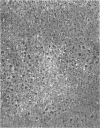Abstract
Information was sought on the temporal distribution of transmissible mink encephalopathy virus in royal pastel mink inoculated subcutaneously with 10(3.0) 50% intracerebral lethal doses of the Idaho strain. As determined by intracerebral assay in mink, extremely little replication of the virus occurred during the preclinical stage of infection. It seemed largely limited to lymph nodes draining the site of inoculation. Virus first appeared in the central nervous system (CNS) at 20 weeks, when all mink were still clinically normal. Early spongiform degeneration, limited to the posterior sigmoid gyrus of the frontal cortex, was first found at 28 weeks, or a few weeks before onset of clinical disease in most of the mink. Once virus reached the CNS, where greater concentrations occurred than elsewhere, it appeared in many extraneural sites (spleen, liver, kidney, intestine, mesenteric lymph node, and submandibular salivary gland). These seemingly anomalous findings, especially the limited extraneural replication of virus as a prelude to infection of the CNS, suggest that mink are not natural hosts of the virus. The results of this study support the generally held view that transmissible mink encephalopathy arises from chance or inadvertent infection of ranch mink with an exogenous virus, most likely feed-borne wild scrapie virus.
Full text
PDF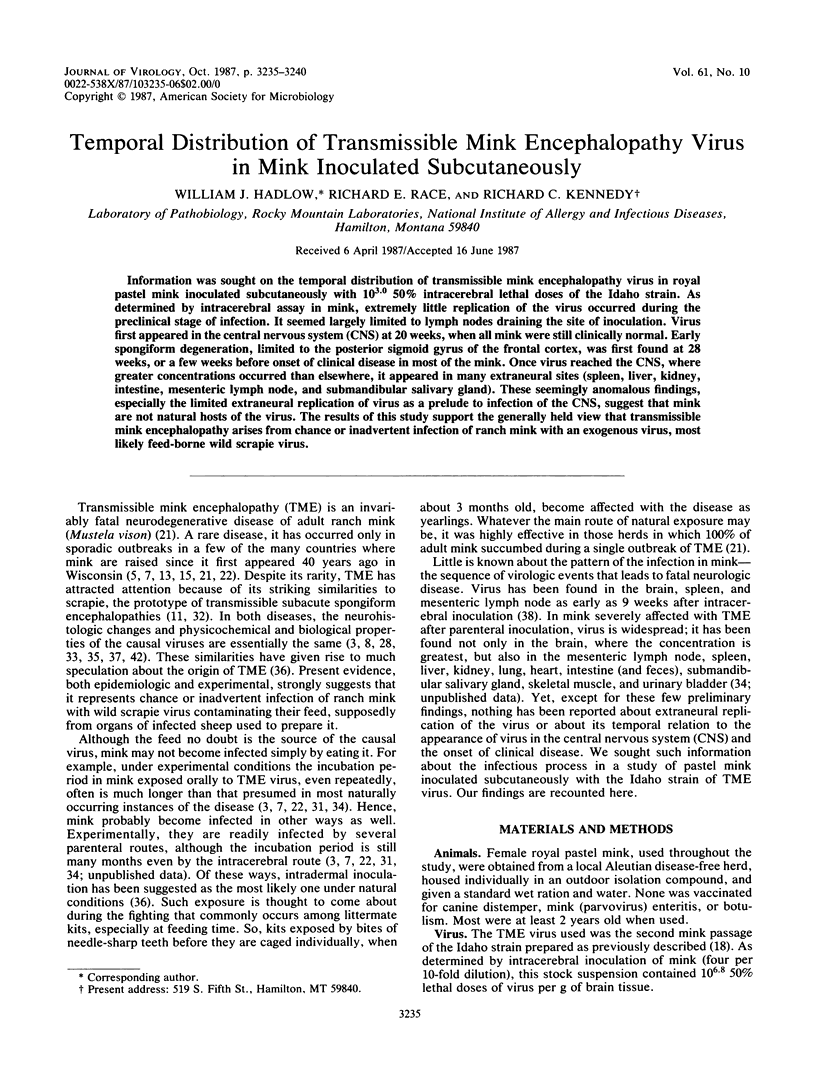
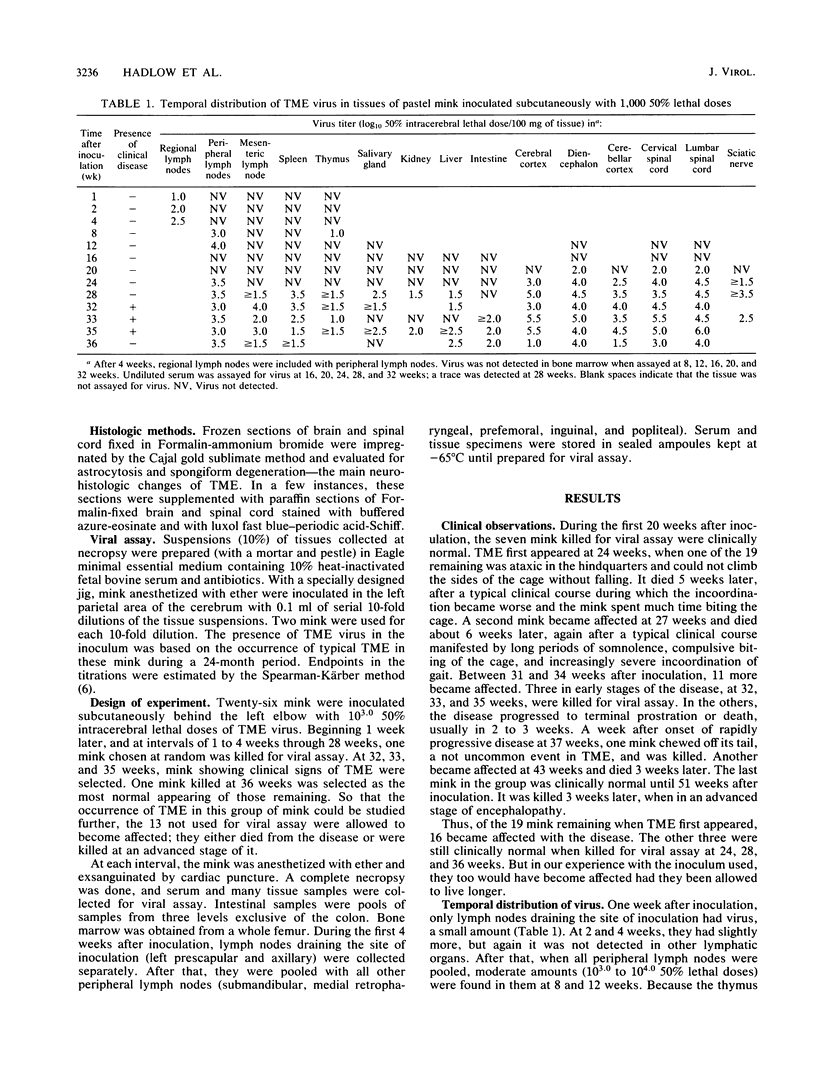
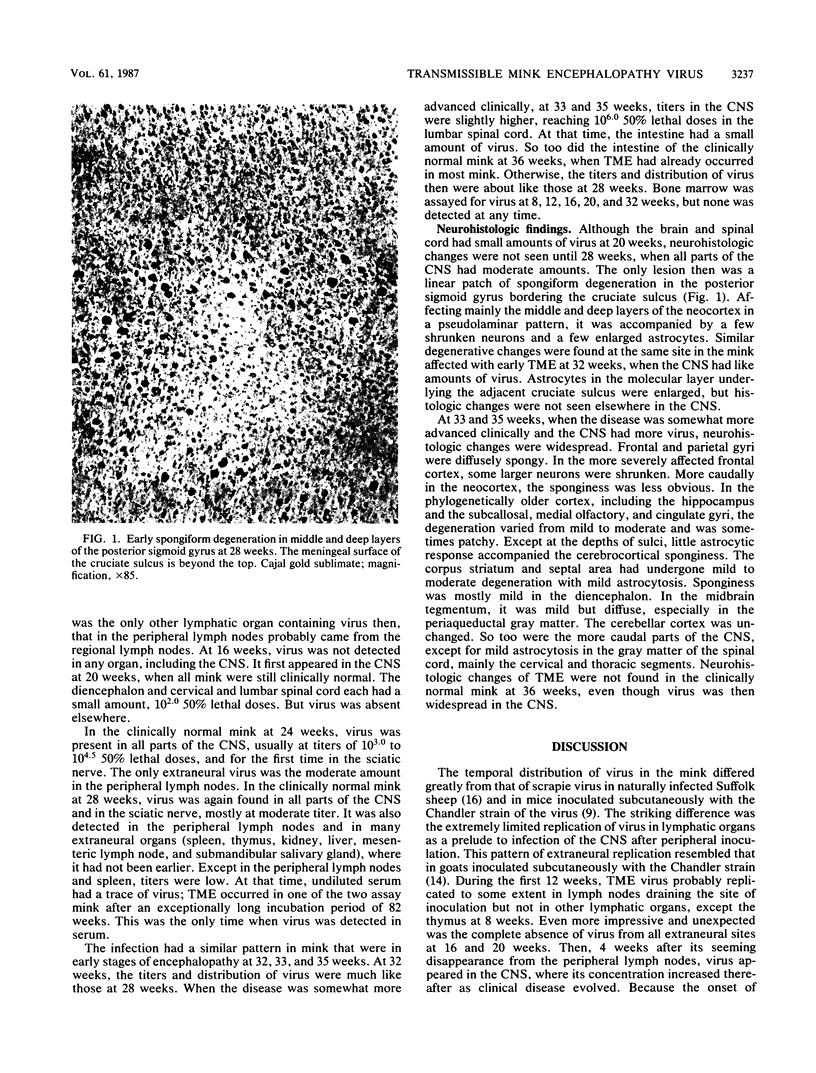
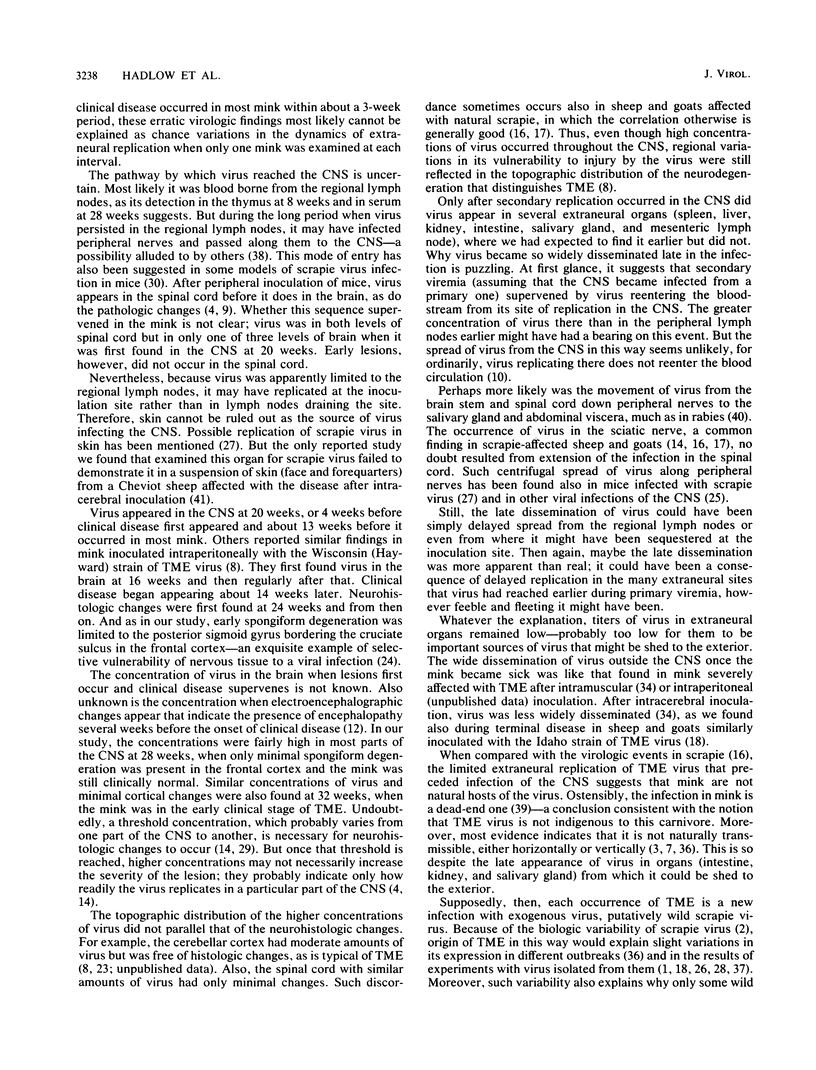
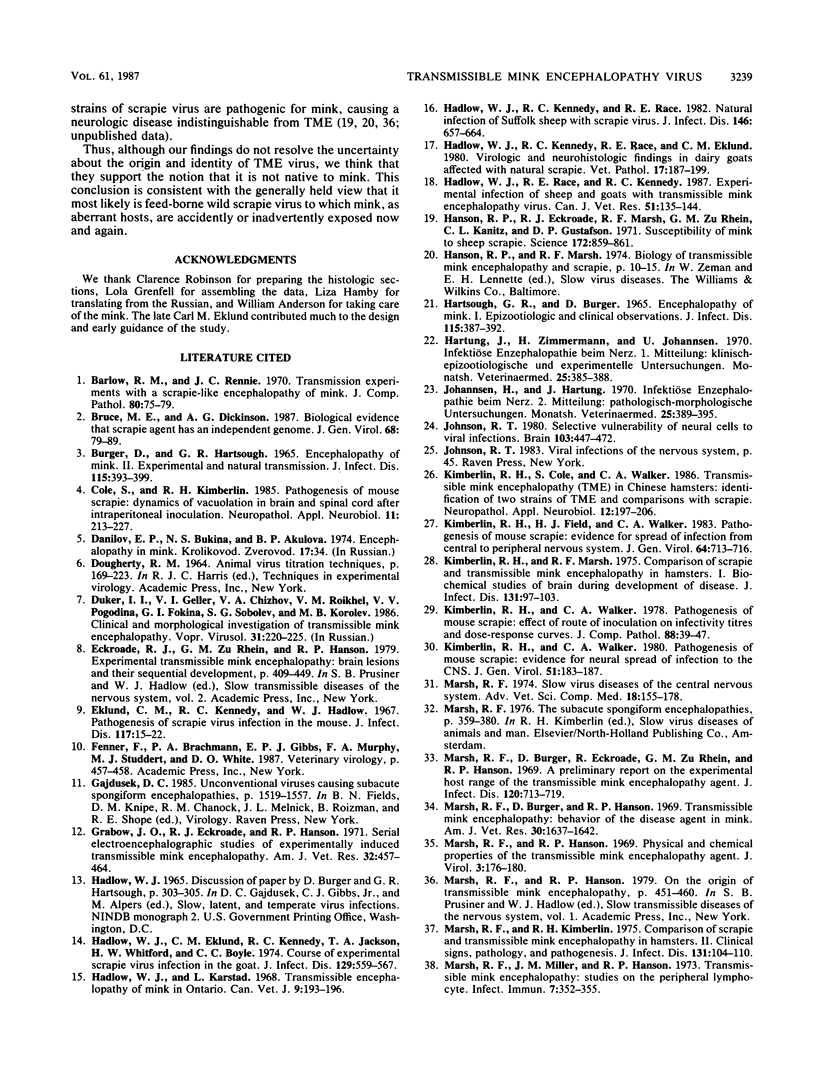
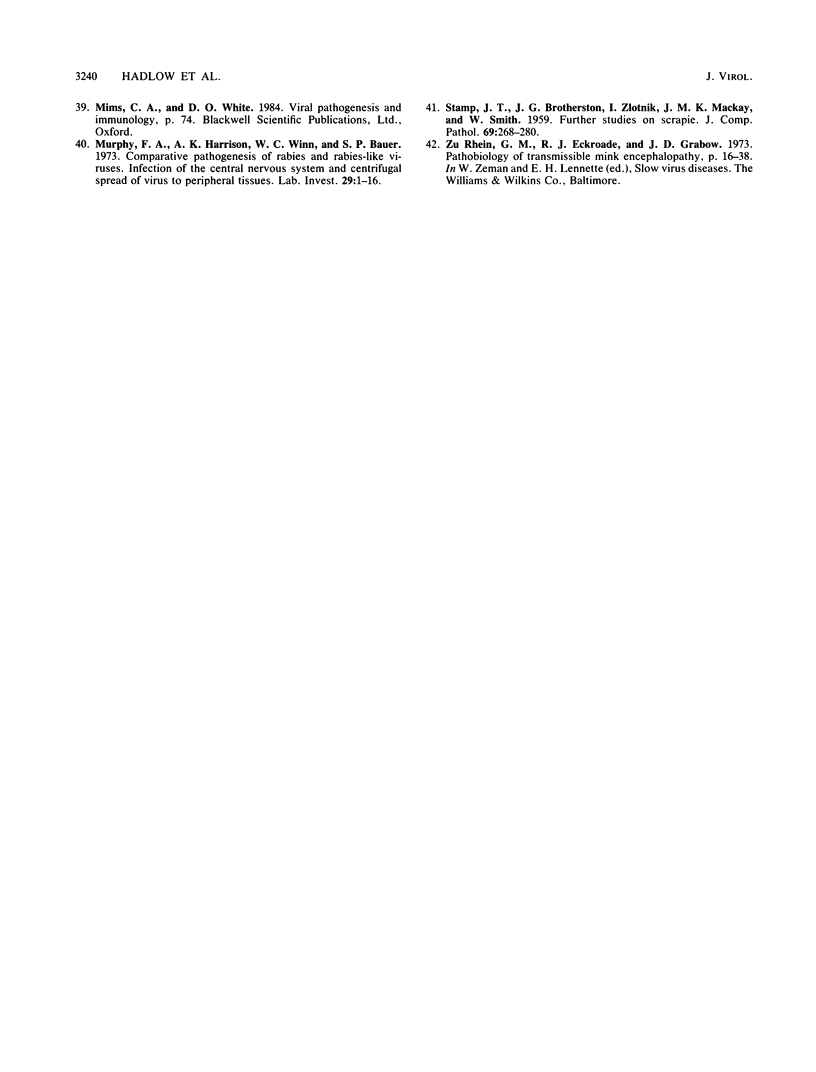
Images in this article
Selected References
These references are in PubMed. This may not be the complete list of references from this article.
- Barlow R. M., Rennie J. C. Transmission experiments with a scrapie-like encephalopathy of mink. J Comp Pathol. 1970 Jan;80(1):75–79. doi: 10.1016/0021-9975(70)90033-2. [DOI] [PubMed] [Google Scholar]
- Bruce M. E., Dickinson A. G. Biological evidence that scrapie agent has an independent genome. J Gen Virol. 1987 Jan;68(Pt 1):79–89. doi: 10.1099/0022-1317-68-1-79. [DOI] [PubMed] [Google Scholar]
- Burger D., Hartsough G. R. Encephalopathy of mink. II. Experimental and natural transmission. J Infect Dis. 1965 Oct;115(4):393–399. doi: 10.1093/infdis/115.4.393. [DOI] [PubMed] [Google Scholar]
- Cole S., Kimberlin R. H. Pathogenesis of mouse scrapie: dynamics of vacuolation in brain and spinal cord after intraperitoneal infection. Neuropathol Appl Neurobiol. 1985 May-Jun;11(3):213–227. doi: 10.1111/j.1365-2990.1985.tb00019.x. [DOI] [PubMed] [Google Scholar]
- Dukur I. I., Geller V. I., Chizhov V. A., Roikhel' V. M., Pogodina V. V. Kliniko-morfologicheskoe izuchenie transmissivnoi éntsefalopatii norok. Vopr Virusol. 1986 Mar-Apr;31(2):220–225. [PubMed] [Google Scholar]
- Eklund C. M., Kennedy R. C., Hadlow W. J. Pathogenesis of scrapie virus infection in the mouse. J Infect Dis. 1967 Feb;117(1):15–22. doi: 10.1093/infdis/117.1.15. [DOI] [PubMed] [Google Scholar]
- Grabow J. D., Eckroade R. J., Hanson R. P. Serial electroencephalographic studies of experimentally induced transmissible mink encephalopathy. Am J Vet Res. 1971 Mar;32(3):457–464. [PubMed] [Google Scholar]
- Hadlow W. J., Eklund C. M., Kennedy R. C., Jackson T. A., Whitford H. W., Boyle C. C. Course of experimental scrapie virus infection in the goat. J Infect Dis. 1974 May;129(5):559–567. doi: 10.1093/infdis/129.5.559. [DOI] [PubMed] [Google Scholar]
- Hadlow W. J., Karstad L. Transmissible encephalopathy of mink in Ontario. Can Vet J. 1968 Aug;9(8):193–196. [PMC free article] [PubMed] [Google Scholar]
- Hadlow W. J., Kennedy R. C., Race R. E., Eklund C. M. Virologic and neurohistologic findings in dairy goats affected with natural scrapie. Vet Pathol. 1980 Mar;17(2):187–199. doi: 10.1177/030098588001700207. [DOI] [PubMed] [Google Scholar]
- Hadlow W. J., Kennedy R. C., Race R. E. Natural infection of Suffolk sheep with scrapie virus. J Infect Dis. 1982 Nov;146(5):657–664. doi: 10.1093/infdis/146.5.657. [DOI] [PubMed] [Google Scholar]
- Hadlow W. J., Race R. E., Kennedy R. C. Experimental infection of sheep and goats with transmissible mink encephalopathy virus. Can J Vet Res. 1987 Jan;51(1):135–144. [PMC free article] [PubMed] [Google Scholar]
- Hanson R. P., Eckroade R. J., Marsh R. F., Zu Rhein G. M., Kanitz C. L., Gustafson D. P. Susceptibility of mink to sheep scrapie. Science. 1971 May 21;172(3985):859–861. doi: 10.1126/science.172.3985.859. [DOI] [PubMed] [Google Scholar]
- Hartsough G. R., Burger D. Encephalopathy of mink. I. Epizootiologic and clinical observations. J Infect Dis. 1965 Oct;115(4):387–392. doi: 10.1093/infdis/115.4.387. [DOI] [PubMed] [Google Scholar]
- Hartung J., Zimmermann H., Johannsen U. Infektiöse Enzephalopathie beim Nerz. 1. Klinisch-epizootiologische und experimentelle Untersuchungen. Monatsh Veterinarmed. 1970 May 15;25(10):385–388. [PubMed] [Google Scholar]
- Johannsen U., Hartung J. Infektiöse Enzephalopathie beim Nerz. 2. Patholgisch-morphologische Untersuchungen. Monatsh Veterinarmed. 1970 May 15;25(10):389–395. [PubMed] [Google Scholar]
- Johnson R. T. Selective vulnerability of neural cells to viral infections. Brain. 1980 Sep;103(3):447–472. doi: 10.1093/brain/103.3.447. [DOI] [PubMed] [Google Scholar]
- Kimberlin R. H., Cole S., Walker C. A. Transmissible mink encephalopathy (TME) in Chinese hamsters: identification of two strains of TME and comparisons with scrapie. Neuropathol Appl Neurobiol. 1986 Mar-Apr;12(2):197–206. doi: 10.1111/j.1365-2990.1986.tb00050.x. [DOI] [PubMed] [Google Scholar]
- Kimberlin R. H., Field H. J., Walker C. A. Pathogenesis of mouse scrapie: evidence for spread of infection from central to peripheral nervous system. J Gen Virol. 1983 Mar;64(Pt 3):713–716. doi: 10.1099/0022-1317-64-3-713. [DOI] [PubMed] [Google Scholar]
- Kimberlin R. H., Marsh R. F. Comparison of scrapie and transmissible mink encephalopathy in hamsters. I. Biochemical studies of brain during development of disease. J Infect Dis. 1975 Feb;131(2):97–103. doi: 10.1093/infdis/131.2.97. [DOI] [PubMed] [Google Scholar]
- Kimberlin R. H., Walker C. A. Pathogenesis of mouse scrapie: effect of route of inoculation on infectivity titres and dose-response curves. J Comp Pathol. 1978 Jan;88(1):39–47. doi: 10.1016/0021-9975(78)90059-2. [DOI] [PubMed] [Google Scholar]
- Kimberlin R. H., Walker C. A. Pathogenesis of mouse scrapie: evidence for neural spread of infection to the CNS. J Gen Virol. 1980 Nov;51(Pt 1):183–187. doi: 10.1099/0022-1317-51-1-183. [DOI] [PubMed] [Google Scholar]
- Marsh R. F., Burger D., Eckroade R., Zu Rhein G. M., Hanson R. P. A preliminary report on the experimental host range of the transmissible mink encephalopathy agent. J Infect Dis. 1969 Dec;120(6):713–719. doi: 10.1093/infdis/120.6.713. [DOI] [PubMed] [Google Scholar]
- Marsh R. F., Hanson R. P. Physical and chemical properties of the transmissible mink encephalopathy agent. J Virol. 1969 Feb;3(2):176–180. doi: 10.1128/jvi.3.2.176-180.1969. [DOI] [PMC free article] [PubMed] [Google Scholar]
- Marsh R. F., Hanson R. P. Transmissible mink encephalopathy: neuroglial response. Am J Vet Res. 1969 Sep;30(9):1637–1642. [PubMed] [Google Scholar]
- Marsh R. F., Kimberlin R. H. Comparison of scrapie and transmissible mink encephalopathy in hamsters. II. Clinical signs, pathology, and pathogenesis. J Infect Dis. 1975 Feb;131(2):104–110. doi: 10.1093/infdis/131.2.104. [DOI] [PubMed] [Google Scholar]
- Marsh R. F., Miller J. M., Hanson R. P. Transmissible mink encephalopathy: studies on the peripheral lymphocyte. Infect Immun. 1973 Mar;7(3):352–355. doi: 10.1128/iai.7.3.352-355.1973. [DOI] [PMC free article] [PubMed] [Google Scholar]
- Marsh R. F. Slow virus diseases of the central nervous system. Adv Vet Sci Comp Med. 1974;18(0):155–178. [PubMed] [Google Scholar]
- Marsh R. F. The subacute spongiform encephalopathies. Front Biol. 1976;44:359–380. [PubMed] [Google Scholar]
- Murphy F. A., Harrison A. K., Winn W. C., Bauer S. P. Comparative pathogenesis of rabies and rabies-like viruses: infection of the central nervous system and centrifugal spread of virus to peripheral tissues. Lab Invest. 1973 Jul;29(1):1–16. [PubMed] [Google Scholar]
- STAMP J. T., BROTHERSTON J. G., ZLOTNIK I., MACKAY J. M., SMITH W. Further studies on scrapie. J Comp Pathol. 1959 Jul;69:268–280. doi: 10.1016/s0368-1742(59)80026-6. [DOI] [PubMed] [Google Scholar]



